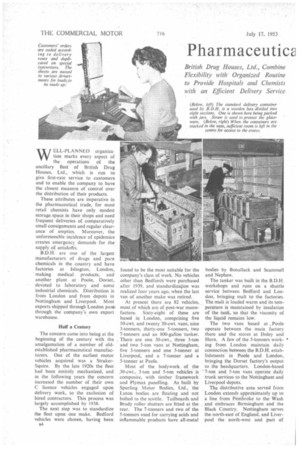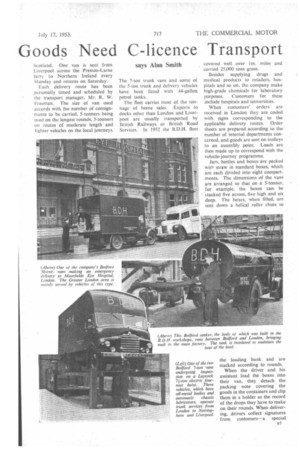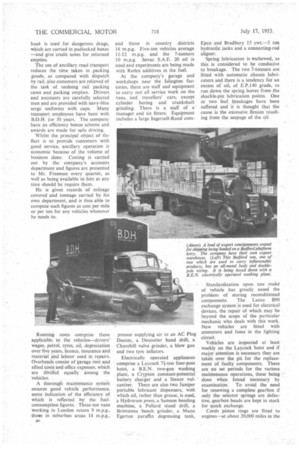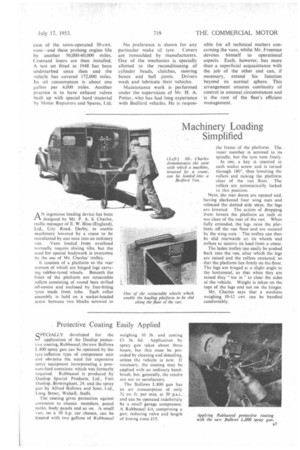Pharmaceutics Goods Need C-licence Transport
Page 38

Page 39

Page 40

Page 41

If you've noticed an error in this article please click here to report it so we can fix it.
WELL-PLANNED organization marks every aspect of the operations of the ancillary fleet of British Drug Houses, Ltd., which is run to give first-rate service to customers and to enable the company to have the closest measure of control over the distribution of their products.
These attributes are imperative in the pharmaceutical trade, for most retail chemists have only modest storage space in their shops and need frequent deliveries of comparatively small consignments and regular clearance of empties. Moreover, the unforeseeable incidence of epidemics creates emergency demands for the supply of antidote's.
B.D.H. are one of the largest manufacturers of drugs and pure chemicals in the country and have factories at Islington, London, making medical products, and another plant at Poole, Dorset, devoted to laboratory and some industrial chemicals. Distribution is from London and from depots in Nottingham and Liverpool. Most exports shipped through London pass through the company's own export warehouse.
Half a Century The concern came into being at the beginning of the century with the amalgamation of a number of oldestablished pharmaceutical manufacturers. One of the earliest motor vehicles acquired was a StrakerSquire. By the late 1920s the fleet had been entirely mechanized, and in the following years the concern increased the number of their own C licence vehicles engaged upon delivery work, to the exclusion of hired contractors. This process was largely accomplished by 1938.
The next step was to standardize the fleet upon one make. Bedford vehicles were chosen, having been found to be the most suitable for the company's class of work. No vehicles other than Bedfords were purchased after 1939, and standardization was realized four years ago, when the last van of another make was retired.
At present there are 82 vehicles, most of which are of post-war manufacture. Sixty-eight of these are based in London, comprising five 10-cwt. and twenty 30-cwt. vans, nine 3-tonners, thirty-one 5-tonners, two 7-tonners and an 800-gallon tanker. There are one 30-cwt., three 3-ton and two 5-ton vans at Nottingham, five 3-tonners and one 5-tonner at Liverpool, and a 7-tonner and a 5-tonner at Poole.
Most of the bodywork of the _30-cwt., 3-ton and 5-ton vehicles is composite, with timber framework and Plymax panelling. As built by Spurting Motor Bodies, Ltd., the Luton bodies are floating and not bolted to the scuttle. Tailboards and Brady roller shutters are fitted at the rear. The 7-tonners and two of the 5-tonners used for carrying acids and inflammable products have all-metal bodies by Bonallack and Scammell and Nephew.
The tanker was built in the B.D.H. workshops and runs on a shuttle service between Bedford and London, bringing malt to the factories. The malt is loaded warm and its temperature is maintained by insulation of the tank, so that the viscosity of the liquid remains low.
The two vans based at Poole operate between the .main factory there and the stores at lbsley and Hum. A few of the 5-tonners work• ing from London maintain daily connection between the B.D.H. establishments in Poole and London, bringing the Dorset factory's output to the headquarters. London-based 7-ton and 5-ton vans operate daily trunk services to the Nottingham and Liverpool depots.
The distributive area served from London extends approximately up to a line from Pembroke to the Wash and embraces Birmingham and the Black Country. Nottingham serves the north-east of England, and Liverpool the north-west and part of
Scotland. One van is sent from Liverpool across the Preston-Larne ferry to Northern Ireland every Monday and returns on Saturday.
Each delivery route has been personally timed and scheduled by the transport manager, Mr. R. W. Freeman. The size of van used accords with the number of consignments to be carried, 5-tonners being used on the longest rounds, 3-tonners on routes of moderate length and lighter vehicles on the local journeys.
The 7-ton trunk vans and some of the 5-ton trunk and delivery vehicles have been fitted with 44-gallon petrol tanks.
The fleet carries most of the tonnage of home sales. Exports to docks other than London and Liverpool are usually transported by British Railways or British Road Services. In 1952 the 13.D.H. fleet covered well over 1m. miles and carried 25,000 tons gross_ Besides supplying drugs and medical products to retailers, hospitals and so on, the company make high-grade chemicals for laboratory purposes. Customers for these include hospitals and universities.
When customers' orders are received in London they are coded with signs corresponding to the applicable delivery routes. Order sheets are prepared according to the number of internal departments concerned, and goods are sent on trolleys to an assembly point. Loads are then made up to correspond with the vehicle-journey programme.
Jars, bottles and boxes are packed with straw in standard boxes, which are each divided into eight compartments. The dimensions of the vans are arranged so that on a 5-tonner, for example, the boxes can. be stacked five across, five high and six deep. The boxes, when filled, are sent down a helical roller chute to boor is used for dangerous drugs, which are carried in padlocked boxes —and give credit notes for returned empties.
The use of ancillary road transport reduces the time taken in packing goods, as compared with dispatch by rail, also customers are relieved of the task of undoing rail packing cases and packing empties. Drivers and assistants are carefully selected men and are provided with navy-blue serge uniforms with caps. Many transport employees have been with B.D.H. for 30 years. The company' have an efficiency bonus scheme and awards are made for safe driving.
Whilst the principal object of the fleet is to provide customers with good service, ancillary operation is economic because of the volume of business done. Costing is carried out by the company's accounts department and figures are presented to Mr. Freeman every quarter, as well as being available to him at any time should he require them.
He is given records of mileage covered and tonnage carried by his own department, and is thus able to compute such figures as cost per mile or per ton for any vehicles whenever he needs to.
Running costs comprise those applicable to the vehicles—drivers' wages, petrol, tyres, oil, depreciation over five years, licence, insurance and material and labour used in repairs. Overheads consist of garage rent and allied costs and office expenses, which are divided equally among the vehicles.
A thorough maintenance system ensures good vehicle performance, some indication of the efficiency Of which is reflected by the fuelconsumption figures. Three-ton vans working in London return 9 m.p.g., those in suburban areas 14 m.p.g.,
at,
and those in country districts 16 m.p.g. Five-ton vehicles average 11-12 m.p.g. and the 7-tonners 10 m.p.g. Sovac S.A.E. 20 oil is used and experiments are being made with Redex additives in the fuel.
At the company's garage and workshops near the Islington factories, there are staff and equipment to carry out all service work on the vans, and travellers' cars, except cylinder boring and crankshaft grinding. There is a staff of a manager and six fitters. Equipment includes a large Ingersoll-Rand corn pressor supplying air to an AC Plug Doctor, a Desoutter hand drill, a Churchill valve grinder, a blow gun and two tyre inflators.
Electrically operated appliances comprise a Laycock 71-ton four-post hoist, a B.E.N. two-gun washing plant, a Crypton constant-potential battery charger and a Stenor vulcanizer. There are also two Juniper portable lubricant dispensers, with • which oil, rather than grease, is used, a Hydroram press, a Samson bending machine, a Pollard stand drill, a Brimstone bench grinder, a Mann Egerton paraffin degreasing tank, Epco and Bradbury 15 cwt.-5 ton hydraulic jacks and a connecting-rod aligner.
Spring lubrication is eschewed, as this is considered to be conducive to breakage. The two 7-tanners are fitted with automatic chassis lubricators and there is a tendency for an excess of oil, of E.P.140 grade, to run down the spring leaves from the shackle-pin lubrication points. One or two leaf breakages have been suffered and it is thought that the cause is the excessive flexion resulting from the seepage of the oil.
Standardization upon one make of vehicle has greatly eased the problem of storing reconditioned components. The Lucas B90 exchange system is used for electrical devices, the repair of which may be beyond the scope of the particular mechanic who deals with this work. New vehicles are fitted with ammeters and fuses in the lighting circuit.
Vehicles are inspected at least weekly on the Laycock hoist and if major attention is necessary they are taken over the pit for the replacement of faulty components. There are no set periods for the various maintenance operations, these being done when found necessary by examination. To avoid the need for renewing a complete gearbox if only the selector springs are defective, gearbox heads are kept in stock for quick exchange.
Cords piston rings are fitted to engines—at about 20,000 miles in the
case of the town-operated 30-cwt. vans —and these prolong engine life by another 50,000-60,000 miles. Cromard liners are then installed. A test set fitted in 1948 has been undisturbed since then and the vehicle has covered 172,000 miles. its oil consumption is about one gallon per 4,000 mites. Another practice is to have exhaust valves built up with special hard 'material by Motor Repairers and Spares, Ltd.
No preference is shown for any particular make of tyre. Covers are 'remoulded by manufacturers. One of the mechanics is specially allotted to the reconditioning of cylinder heads, clutches, steering boxes and ball joints_ Drivers wash and lubricate their vehicles.
Maintenance work is performed under the supervision of Mr. H. A. Potter, who has had long experience with Bedford vehicles. He is respon
sible for all technical matters concerning the vans, whilst Mr. Freeman devotes himself to operational aspects. Each, however, has more than a superficial acquaintance with the job of the other and can, if necessary, extend his function beyond its normal sphere. This arrangement ensures continuity of control in unusual circumstances and is the root of the fleet's efficient management.




















































































